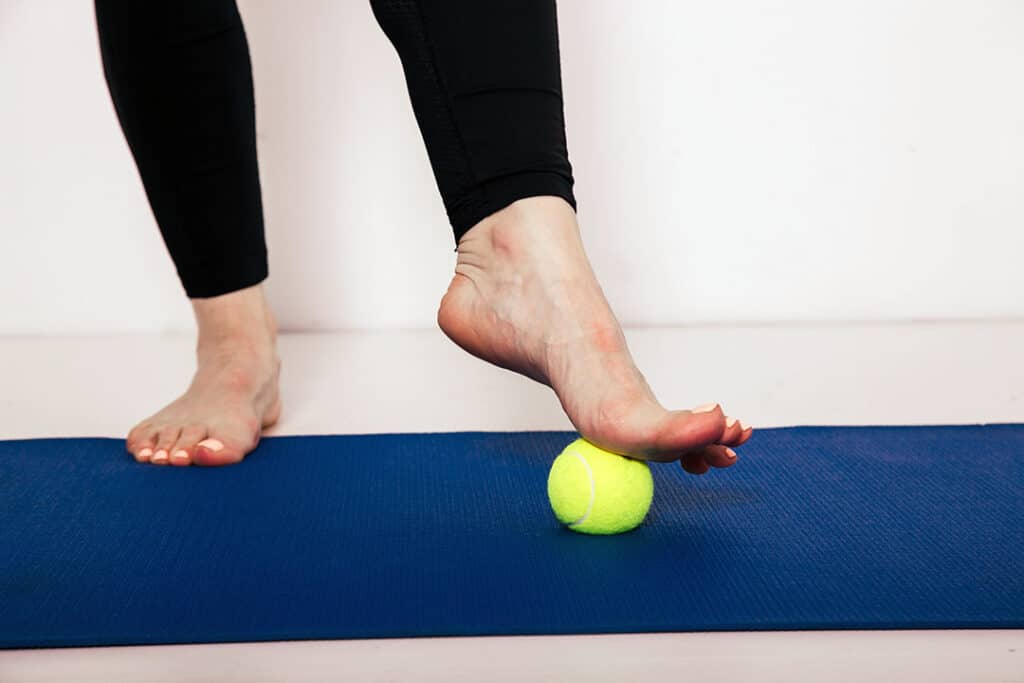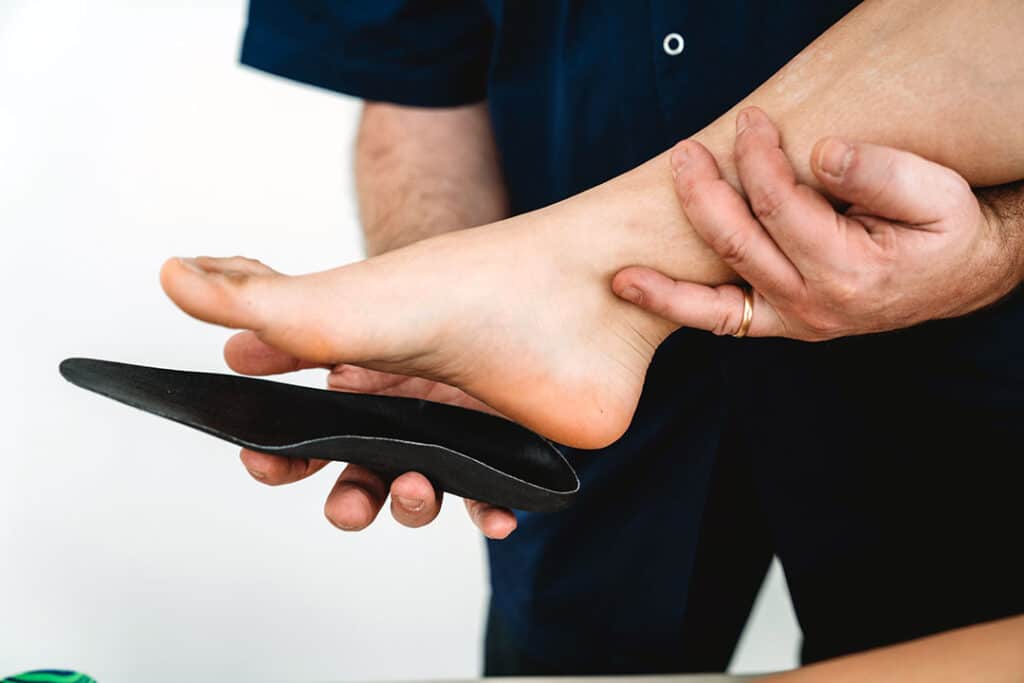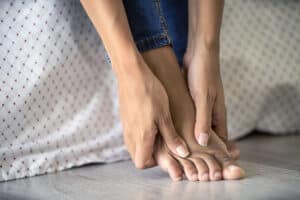Foot pain has a way of stopping you in your tracks. Especially if you’re experiencing the frustrating and often excruciating pain of plantar fasciitis.

About 1 in 10 people can expect to have plantar fasciitis in their lifetime. This painful foot condition not only limits your ability to move with ease but can also lead to structural issues and pain in other areas of your body.
If you want to overcome plantar fasciitis, rest and care for your feet are essential. But if you’re like most people, you probably can’t afford to simply stay off your feet all day – there are things to do!
Here’s the good news: plantar fasciitis may be frustrating, but it is treatable. With chiropractic care, strategic stretching, and a few other tips, you can stop the pain and heal your feet.
What is Plantar Fasciitis?

The plantar fascia is a thick band of connective tissue that connects the heel to the front of the foot. It acts as a supportive web and shock absorber. Unfortunately, this tissue can get inflamed and lead to a painful condition called plantar fasciitis.
Plantar fasciitis is one of the most common causes of foot pain and stiffness. It usually occurs when there has been excessive wear and tear on the feet, often after long periods of standing or injuries.
To most people, plantar fasciitis pain feels like a burning or a dull ache on the bottom of their feet or at the heel. While it most commonly affects just one foot, you can experience plantar fasciitis in both feet.
What causes plantar fasciitis?
Plantar fasciitis is caused by chronic inflammation that damages this band of tissue. But what causes the inflammation?
- Small tears in the tissue from overuse or overstretching
- High levels of activity (especially long-distance running)
- Excess pressure on the feet during pregnancy or weight gain
- Long periods of being on your feet without rest
- Tightness in the Achilles tendon or calf muscle that pulls on the plantar fascia
- Wearing soft shoes or those without arch support
But not all plantar pain is inflammatory. Some people simply have an anatomical foot or leg structure that predisposes them to plantar fasciitis, such as high arches or flat feet. In some cases, degeneration may be at the root of stiff, achy feet. This is better known as plantar fasciosis.
Why does plantar fasciitis flare up sometimes?
Plantar fasciitis pain typically flares with either too much or not enough activity. After sleep or a long period of inactivity, the fascia can feel stiff and sore. This is why pain is usually at its worst in the morning. Excess walking, running, standing, or climbing can cause a flare, too. Although, most people feel the pain only after they stop moving, rather than during activities.
Because plantar fasciitis is an inflammatory condition, anything that increases inflammation in the body could lead to a flare. Eating an anti-inflammatory diet, drinking plenty of water, and avoiding sugar, processed foods, and other inflammatory substances can help keep flares to a minimum.
How long does plantar fasciitis last?
For some, plantar fasciitis comes and goes. For others, it lingers on endlessly. Most people report relief after 3-12 months. However, you can speed up this process by managing your plantar fasciitis pain with chiropractic care, proper foot care, and healing supplements.
How Chiropractic Can Help with Plantar Fasciitis

Chiropractic care offers an effective treatment for plantar fasciitis pain. Precise and targeted treatments for the feet are combined with adjustments that support the entire chain of movement, from toe to spine. So, how does it work?
- Chiropractic reduces stress and inflammation in the plantar fascia. Special treatments that relax and loosen the plantar fascia help to quiet pain and prevent fascia tears and inflammation. Adjustments are also made to the foot bones, heel, and ankle to reduce unnecessary pressure on the foot and promote relaxation.
- Chiropractic addresses imbalances in the entire musculoskeletal system. Oftentimes, plantar fascia pain does not originate with an issue in the fascia itself, but in the tendons, calf muscles, or even spine that affect the fascia. By addressing these root causes, plantar fasciitis pain can be reversed and prevented.
- Chiropractic promotes whole-body healing and prevents re-injury. Chiropractic adjustments allow for better blood flow and relaxation through the foot – and the body as a whole. With less pressure on your feet and reduced inflammation in your body, the fascia and surrounding tissues have a better chance of healing. Your chiropractor also helps you adjust your posture and walking habits so you can prevent further injuries and move pain-free.
Tips for Well-Rounded Foot Pain Relief
Along with chiropractic adjustments, your AlignLife chiropractor may also recommend some of these daily exercises or lifestyle habits to help you reduce your pain faster.
1) Learn How to Stretch for Plantar Fasciitis

Knowing how to stretch is essential if you want to heal your plantar fasciitis naturally. This daily habit helps loosen the tight fascia, which can help prevent tearing and pain. It also helps strengthen the muscles of the feet to better support your overall foot health.
Your AlignLife chiropractor will walk you through how to stretch your foot daily, based on the root cause of your pain.
How to do it: For general stretching, be sure to stretch enough that you feel the stretch, but not so hard or intense that it causes pain. Stretch the toes, the sole, and the calves. Try to work in a 5-minute stretch first thing in the morning, a couple of times throughout the day, and before bed.
2) Try these Exercises & Stretches

Foot stretches and exercises help improve the strength and mobility of your feet while encouraging healing circulation through the foot’s fascia. Try some of these favorite foot stretches and exercises at home:
Arch Roll Massage
One of the most commonly used exercises for plantar fasciitis is rolling your foot over a tennis ball. This exercise “irons out” that stiff and inflamed fascia, flushes the area with healing blood flow, and eases the pain.
How to do it: From a sitting position, place your arch on top of a tennis ball and gently roll your inner arch on the ball. While a tennis ball is traditional, you can also try this exercise with a frozen can, frozen water bottle, or golf ball.
Towel Pick-Up
The towel pick-up is a toe-curling exercise that helps reduce foot pain, especially in the morning or after a long period of inactivity.
How to do it: Place a hand towel on the floor. Try to grasp the towel with the toes on your affected foot by curling them inward to pull the towel towards you. Grasp the towel 10 times, resting for a few seconds in between each rep.
Towel Stretch
Use that same hand towel to give your sole a satisfying stretch. This exercise is great for morning stiffness, or anytime you need to get a little relief.
How to do it: Place the affected foot out in front of you. Place the towel around your foot, holding each end to cradle the foot in the towel. Pull the ends towards you to stretch your foot and calf muscle. Hold for 30-45 seconds. Rest and repeat 5 times.
Calf Stretches
Tight calf muscles are often at the root of plantar fasciitis. This exercise helps stretch and lengthen the calf muscles and tendons to reduce tension on the plantar fascia.
How to do it: Place both your hands on a sturdy wall, keeping your feet on the ground. Bend the knee on the unaffected leg while straightening the affected leg with the painful foot. As you do this, you will feel a stretch along the calf, heel, and into the bottom of your foot. Hold this stretch for 10-15 seconds. Rest, and repeat 3-5 times. It’s a good idea to stretch the unaffected leg as well, to prevent calf tightness and plantar pain from developing there as well.
3) Take Supplements to Ease Inflammation

Because of the inflammatory nature of plantar fasciitis, a supplement that provides cooling and balancing relief is key.
Aceva’s Mobility supplement is a powerful antioxidant, anti-inflammatory blend of healing herbs that helps eliminate pain. It includes medicinal plant extracts such as turmeric, black pepper, Indian frankincense, and white willow bark to stop the pain, increase blood flow, and neutralize inflammation. Along with helping the foot heal from chronic inflammation, Aceva Mobility also improves the flexibility and mobility of the foot itself to prevent future foot pain.
4) Wear the Best Shoes for Plantar Fasciitis

Wearing the wrong type of shoe can make plantar fasciitis pain worse and prevent your foot from healing. In general, avoid any shoe that feels tight, has pointed toes, or has a flat bottom with no arch support (like flip flops).
The best shoes for plantar fasciitis are wide, comfortable shoes with a custom orthotic. This is a special insert, designed to fit your feet’s unique curves. At AlignLife, we use 3D foot scanning technology to help you achieve a perfect fit with custom orthotics.
Tired of Living with Plantar Fasciitis? Take the First Step to Pain Relief

For you, plantar fasciitis might be just a casual annoyance. Or perhaps it is severely limiting your daily life. Either way, chiropractic can help you stop the pain, so you can move forward with comfort and confidence.
Schedule a visit with your local AlignLife chiropractor today to start your journey and heal plantar fasciitis for good.



